Related Research Articles

Cosworth is a British automotive engineering company founded in London in 1958, specialising in high-performance internal combustion engines, powertrain, and electronics for automobile racing (motorsport) and mainstream automotive industries. Cosworth is based in Northampton, England, with facilities in Cottenham, England, Silverstone, England, and Indianapolis, IN, US.
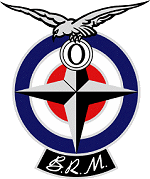
British Racing Motors (BRM) was a British Formula One motor racing team. Founded in 1945 and based in the market town of Bourne in Lincolnshire, it participated from 1951 to 1977, competing in 197 grands prix and winning seventeen. BRM won the constructors' title in 1962 when its driver Graham Hill became world champion. In 1963, 1964, 1965 and 1971, BRM came second in the constructors' competition.

The DFV is an internal combustion engine that was originally produced by Cosworth for Formula One motor racing. The name is an abbreviation of Double Four Valve, the engine being a V8 development of the earlier four-cylinder FVA, which had four valves per cylinder.

The 1966 Italian Grand Prix was a Formula One motor race held at Monza on 4 September 1966. It was race 7 of 9 in both the 1966 World Championship of Drivers and the 1966 International Cup for Formula One Manufacturers. The race was the 36th Italian Grand Prix and the 32nd to be held at Monza. The race was held over 68 laps of the five kilometre circuit for a race distance of 391 kilometres.

A multi-valve or multivalve engine is one where each cylinder has more than two valves. A multi-valve engine has better breathing, and with more smaller valves may be able to operate at higher revolutions per minute (RPM) than a two-valve engine, delivering more power.
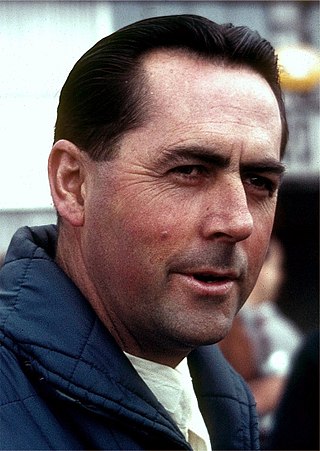
The 1966 Formula One season was the 20th season of FIA Formula One motor racing. It featured the 17th World Championship of Drivers, the 9th International Cup for F1 Manufacturers, and four non-championship races open to Formula One cars. The World Championship was contested over nine races between 22 May and 23 October 1966.
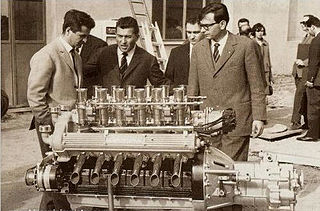
The Lamborghini V12 refers to the flagship V12 engine used by Lamborghini. Lamborghini has had two generations of V12 engines through their history, both of which were developed in-house. The first-generation Lamborghini V12 was a sixty degree (60°) V12 petrol engine designed by Lamborghini, and was the first internal combustion engine ever produced by the firm.

All American Racers is an American-licensed auto racing team and constructor based in Santa Ana, California. Founded by Dan Gurney and Carroll Shelby in 1964, All American Racers initially participated in American sports car and Champ Car races as well as international Formula One events with cars named Eagle. The Formula One team, based in the United Kingdom and using British-built Weslake engines was named Anglo American Racers. Under team manager Bill Dunne they set up shop in Rye, East Sussex. The team were adjacent to Harry Weslake's engine development plant and half a mile from Elva cars. They participated in 25 Grands Prix, entering a total of 34 cars.
Weslake & Co also known as Weslake Research and Development was founded by Harry Weslake, described as England's greatest expert on cylinder head design, with premises in Rye, East Sussex, England. Weslake is most famous for its work with Bentley, Austin, Jaguar and the Gulf-Wyer Ford GT40 Mk.I.

The Honda RA272 was a Formula One racing car designed by Yoshio Nakamura and Shoichi Sano for the 1965 Formula One season. It was the first Japanese car to win in Formula One, achieving victory at the 1965 Mexican Grand Prix after leading every lap with driver Richie Ginther. The win came just two years after Honda started producing road cars, and was the first of 89 victories for Honda-powered Formula One cars.

The Eagle Mk1, commonly referred to as the Eagle T1G, was a Formula One racing car, designed by Len Terry for Dan Gurney's Anglo American Racers team. The Eagle, introduced for the start of the 1966 Formula One season, is often regarded as being one of the most beautiful Grand Prix cars ever raced at the top levels of international motorsport. Initially appearing with a 2.7L Coventry Climax inline 4-cylinder engine, the car was designed around a 3.0L Gurney-Weslake V12 which was introduced after its first four races. In the hands of team boss Gurney, the Eagle-Weslake won the 1967 Belgian Grand Prix, making Dan Gurney only the second driver at the time, and one of only three to date, to win a Formula One Grand Prix in a car of their own construction. Excluding the Indianapolis 500, that win in Belgium still stands as the only win for a USA-built car as well as one of only two wins of an American-licensed constructor in Formula One. It was also the first win for an American constructor in a Grand Prix race since the Jimmy Murphy's triumph with Duesenberg at the 1921 French Grand Prix.
The BRM P351 was originally a Group C sports-prototype built for the 1992 World Sportscar Championship season in an attempt to resurrect the British Racing Motors marque. The car later reappeared in a heavily modified form in 1997 as a Le Mans Prototype known as the BRM P301 before retiring completely in 1998.
This article gives an outline of Formula One engines, also called Formula One power units since the hybrid era starting in 2014. Since its inception in 1947, Formula One has used a variety of engine regulations. Formulae limiting engine capacity had been used in Grand Prix racing on a regular basis since after World War I. The engine formulae are divided according to era.

The Honda RA271 was Honda's first Formula One racing car to enter a race. The chief engineer on the project was Yoshio Nakamura, with Tadashi Kume in charge of engine development. It was driven in three races during 1964 by American driver Ronnie Bucknum.

The BRM P83 was a Formula One racing car designed by Tony Rudd and Geoff Johnson and built by British Racing Motors for the new engine regulations of 1966. It used a highly unorthodox H16 engine which caused problems throughout the car's racing life, and despite the best efforts of Graham Hill and Jackie Stewart took BRM from championship contenders to also-rans, leading it to be regarded alongside the BRM Type 15 as another embarrassing failure for the British marque caused by overcomplicated engineering.
Leonard E. Terry was an English racing car designer and engineer, known for his work with Lotus, BRM and Eagle. He also designed chassis for many other teams, including ERA and Aston Martin and produced his own car in which he competed.
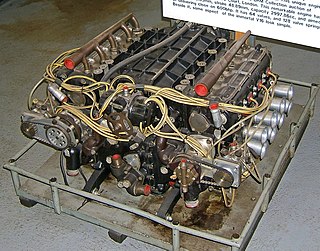
The BRM P75 was a 3-litre H16 motor racing engine, developed by BRM. The engine was relatively competitive but highly unreliable, and was used in Formula One from 1966 to 1968.

Ferrari has made a number of V12 racing engines designed for Formula One; made between 1950 and 1995. Some derived engines were also used in various Ferrari sports prototype race cars and production road cars.
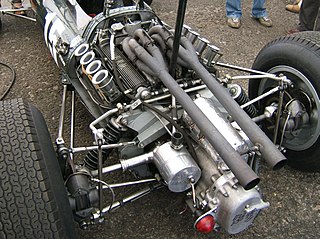
The British Racing Motors V8 was a four-stroke, naturally aspirated, 1.5 L (92 cu in), V-8 racing engine, designed, developed and built by British Racing Motors (BRM) to compete in Formula One racing (although an enlarged 2.0 L version was used for sports car racing. It was built between 1962 and 1967, and came in two version; the P56, and the P60.
The BRM V12 engine is a V12 Formula One racing engine, designed, developed and built by British manufacturer and constructor BRM, between 1967 and 1977.
References
- ↑ http://www.dlg.speedfreaks.org/archive/cars/brm/autos/1010.php
- ↑ Farmer, Dave. "WEIGHTS & SIZES organized by Dave Farmer" (PDF).
- ↑ "1967 All American Racers Eagle Gurney Weslake Mk 1 Formula 1".
- ↑ "Eagle T1G". 27 January 2017.
- ↑ "1966 - 1967 Eagle Mark 1 Weslake - Images, Specifications and Information".
- ↑ "1966 - 1967 Eagle Mark 1 Weslake Specifications". Ultimatecarpage.com.
- ↑ "Eagle Westlake T1G - F1technical.net". www.f1technical.net.
- ↑ "Home". gurney-weslake.co.uk.
- 1 2 "Ford - Weslake V12". 7 July 2014.
- 1 2 Robson, Graham (9 October 2015). Grand Prix Ford: Ford, Cosworth and the DFV. Veloce Publishing. ISBN 9781845846244.
- 1 2 "Ford Weslake V12". www.researchracing-documentation.de.
- ↑ "Time Machine: 1991 BRM P401 & P531". ACI.
- ↑ "BRM P401". ACI.
- ↑ "Eagle F1 Car, Technical | Dan Gurney's All American Racers".
- ↑ "Eagle Westlake T1G". 22 June 2008.
- ↑ "Getting Personal with Dan Gurney's Eagle-Weslake Mk1 at Goodwood". 11 September 2018.
- ↑ "8W - What? - Eagle Gurney-Weslake".
- ↑ "Engine Weslake • STATS F1".
- ↑ "Regeneration game". Motor Sport Magazine. April 2006.
- ↑ "#MotorsportFail – the 1992 WSC BRM P351". 19 March 2015.
- ↑ "The BRM P351 Story | dailysportscar.com". www.dailysportscar.com.
- ↑ "Barely racing - 1992 BRM P351". 3 April 2017.
- ↑ "BRM P351 WSC Group C 1992". GTPlanet. 13 April 2015.
- ↑ "Sports Cars - BRM". 28 March 2015.
- ↑ "imca-slotracing.com". ww12.imca-slotracing.com.